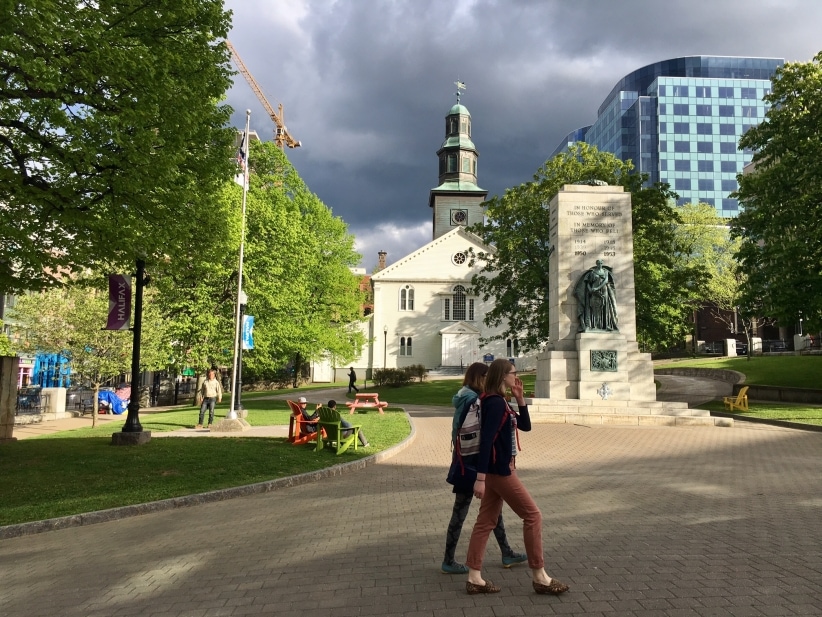
By Martin W.G. King
Fishing villages, farmhouses, churches and vivid green tidal marshes emerged from the dense fog as my wife and I headed up Nova Scotia’s Lighthouse Route, a scenic if slow coastal road, to Halifax, the provincial capital. We were an hour out of Yarmouth, Nova Scotia, where the high-speed CAT car ferry from Portland, Me., on its first voyage of the year, had deposited us late the night before after a rough 212-mile crossing.

Approaching Halifax that evening, my wife driving while I navigated, the memories of my childhood in Halifax came flooding back. I guided Robin through leafy residential neighborhoods that were chock-a-bloc with brightly colored houses directly to our hotel on the historic downtown waterfront. On the way, we passed a movie theater that had been a regular source of entertainment when the only instructions for a 10-year-old were to be home by dinner. (Another childhood destination, the adjacent Candy Bowl, a shop that sold sugary confections and, in summer, frozen treats, had not survived.)
We lucked out with a room facing the channel from which my father, a captain in the Royal Canadian Navy, had guided North Atlantic convoys to Britain in World War II as the commanding officer of a succession of corvettes (tiny but nimble warships). The city’s deep, protected harbor had been the marshaling point for U.S. and Canadian ships bearing arms, munitions, fuel and food to a besieged Britain. Years after the war, after I was born, he had been posted to Halifax again.
Much had changed. The high-rise skyline was new, as were gentrified neighborhoods that had once been slums. The downtown itself had shifted in an entirely different direction, offering chic new boutiques (as well as the shops you’d find in any tourist town). New museums lined a waterfront boardwalk, as did restaurants, sidewalk cafes and more shops. The gargantuan new Seaport Farmers’ Market sat directly below our windows. The Nova Scotia Museum of Art, worthy of a much larger city (Halifax has a population of 270,000) occupied a contemporary space in two landmark buildings in the old downtown.

But much was the same. The city, founded in 1749 by the British, had guarded its historic landmarks judiciously. The Citadel, a massive star-shaped British fortress, still stood guard over the harbor atop the city’s highest hill. The Prince of Wales Martello Tower, another 18th Century fortification, presided over Point Pleasant Park in the city’s South End. St. Paul’s Church, the first Protestant church in Canada, where I had sung in the boys’ choir, anchored the Grand Parade, now a park dotted with deckchairs provided by the city.

Stone warehouses dating to the mid-18th Century had been restored and opened to commerce along the waterfront. One such restoration, the Historic Properties, anchored the northern end. Another, Alexander Keith’s Nova Scotia Brewery, near the southern end, has occupied the same building since 1820 and attracts hordes of visitors to its tours and tastings. The 16-acre Public Gardens, a tranquil oasis in the heart of town, still offered a respite from the city’s bustle.

Nearby ice cream shops were doing a steady business; one, the Dairy Bar, a new start-up serving honey goat cheese-flavored soft ice cream that day, sat diagonally across the street from the park’s towering, ornamental iron gates; it was testimony to the city’s increasingly sophisticated palate. Daniel Crowther, who with Kaiah Singh was filling cones when I stopped by, told me he was bullish on business despite a slow start due to cooler than usual June weather; on warm days, he said, they had been far busier than the year before. Singh chimed in that many of their customers were students at the city’s’ two largest universities, Dalhousie and St. Mary’s.

We stopped next at the market. Stalls selling produce and fruit from the year’s first harvest vied for attention with the meat, fish and cheese counters; local wines and craft ciders also seemed popular. Buskers entertained at the foot of massive twin wooden staircases to the second floor that doubled as bleachers. We ate at Norbert’s Good Food, an inexpensive farm-to-table eatery that serves breakfast and lunch and delectable, gluten-free baked goods.
Outside, a statue of Samuel Cunard lent a commanding presence to a small waterfront plaza. Cunard, founder of the steamship company that still bears his name, was a Haligonian, as Halifax natives are called. He got his start in shipping by building the ferries that, in 1830, began crossing Halifax Harbor. The Cunard Line came later, as did Cunard’s opposition to racial segregation after, unknown to him, Frederick Douglass was confined to his cabin on a transatlantic crossing in 1845. Passenger ferries still cross the harbor; they provide an excellent view of the city for $2.50 CAD roundtrip, vastly less than the cost of a harbor tour.

The new Canadian Museum of Immigration at Pier 21, housed in the former immigration hall, is a high-tech showstopper; it’s adjacent to the market and memorializes the stories of immigrants and refugees, many of whom arrived at this spot. One exhibit is dedicated to the tens of thousands of Syrian refugees that Canada has welcomed since Justin Trudeau became Canada’s prime minister. The museum offers free genealogical services; visitors can work with a staff member to trace, through computerized records, details about an ancestor’s arrival in Canada.
We tried Robin’s family first, as they had disembarked in Nova Scotia after a voyage from Ireland, and, according to family lore, stayed there for a couple of years before journeying to Kansas, where they settled. We struck out, but hit gold when the researcher found records of my grandmother’s passage aboard the Cunard Line’s Caronia from Liverpool to Halifax in 1911, when she was a 20 and single.
The Maritime Museum of the Atlantic, farther north on the boardwalk, explores the role of shipping in Nova Scotia’s history. With 30,000 artifacts, dozens of small craft and a 1913 hydrographic survey ship (a corvette is berthed nearby but is not owned or maintained by the museum), the museum explores Halifax’s maritime heritage. Two exhibits in particular captured our attention. The first dealt with the Halifax Explosion, the 1917 blast that followed the collision of a World War I munitions ship with another vessel. Killing 2,000 and injuring another 9,000, the detonation was the world’s largest man-made explosion before Hiroshima.
Another section focuses on Halifax’s role in recovery operations after the sinking of the Titanic. While survivors were taken to New York, the bodies of many of those who perished were brought to Halifax, the nearest port of any size to the disaster. Among its displays are a wooden Titanic deck chair, recovered from the scene, a huge collection of wooden Titanic objects and body bags. Many of the dead were buried in Halifax’s Fairview Lawn Cemetery.
We also visited the Art Gallery of Nova Scotia, where an exhibit of paintings by the late Maud Lewis, a primitive artist who has gained international stature, was captivating. Her life is the subject of a new movie, Maudie, starring Sally Hawkins and Ethan Hawke. The exhibit even includes Lewis’ tiny house, painstakingly moved into the museum; she painted on every surface—not just the walls and door, but the stove and the breadbox.
I struck up a conversation with Kayliegh Sheehan, the young woman at the reception desk. With a background in writing and the theater, she had spent 10 years in a city near Toronto before being drawn to Halifax by its burgeoning cultural scene. “Halifax is the perfect size,” she said. “It’s got all the amenities of a much larger city, but the whole place feels like one friendly neighborhood.”

She was certainly right about that. The Haligonians we met were universally friendly, especially the people at our hotel, the Nova Scotian, who were happy to lend a hand any way they could. I had a personal connection to the hotel; when I was a child, before there were bridges across the harbor, my father would take me on the old car ferry from our home at a naval base across the harbor to the hotel barbershop for haircuts. I also had memories of another hotel, the venerable Lord Nelson, across the street from the Public Gardens and adjacent to the lively Spring Garden Road shopping district. My family had dined in its restaurant many times. In those days, Halifax restaurants were few and far between; now there is a plethora.
We had dinner one night at Chives Canadian Bistro, which had been praised by critics. A cheery farm-to-table establishment in the old downtown, it occupied a former retail space; the vault served as a wine cellar. Robin enjoyed her inventive chicken dish; me, the Moroccan tangine with scallops, a little less.

We also dined at one the city’s most heralded restaurants, the sparkling Bicycle Thief, named after a character in a 1949 Italian movie, which sits on the boardwalk across from a small yacht basin. My lamb chops in a red wine and cherry demi-glacé were superb. My wife chose the expertly crafted Linguine Fra Diavola.
Before leaving, we made a circuit of the homes my family had lived in when I was young. Our visit to one was momentarily distressing; it had been my family’s last stop before my parents’ divorce. Set on a block of beautiful old homes, it had become the neighborhood’s black sheep, having fallen into an advanced state of neglect. It momentarily brought to mind the old adage, ‘You can’t go home again.’
But I had—quite enjoyably, too.



